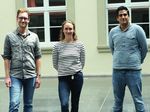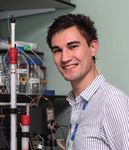ANNUAL REVIEW 2020 HIRI HElmholtz
←
→
Page content transcription
If your browser does not render page correctly, please read the page content below
HIRI HElmholtz
Institute for RNA-based Infection Research
ANNUAL REVIEW 2020
The corona pandemic did not spare the HIRI; it affected all areas of the institute’s daily life and
suddenly presented us with innumerous new challenges. However, thanks to the rapid action of
our scientists, we have been able to contribute to a better understanding of the infection process
of SARS-CoV-2 within a very short time span. At the HIRI, we all pulled together to counter the
pandemic and to establish new routines: A number of “RNA & Infection” PhD students joined us
this year, the new HIRI building is underway and scientific operations were digitized as much as
possible.
Dealing with the pandemic
No area at the HIRI was spared from the
novel corona virus. During the first wave
of infections in spring, it was unclear
which areas of everyday life posed risk,
especially since good nose and mouth
covering masks were in short supply.
Many employees worked from home
for weeks, whilst scientists worked in
the laboratories in shifts. The relaxation
of restrictions in the summer months
created an illusion of normality; however,
the second wave of infections has been
hard-hitting and has demanded an even
greater commitment from all employees.
As the year winds to an end, the world has learnt the good news that several vaccines will soon be approved, including
two based on mRNA. This new hope underlines the HIRI‘s mission to use RNA to combat infectious diseases.
Personnel
This year the HIRI has recruited a number of scientific, technical and administrative
staff. Since September, Sushila Pisano (University of Aberdeen, UK) joined the scientific
coordinators working in public relations.
By the end of the year, the Institute has grown to 80 employees from 18 different
Sushila Pisano joined the science adminis- countries.
tration team in autum 2020. © HIRI / HZI
New building
The new HIRI building became official: In March 2020, the building site was entered into the land register of the city of
Würzburg. In September, the new building was included in Bavaria‘s high-tech agenda, considerably increasing funds as a
result. The demolition of the existing building and the groundbreaking ceremony will take place in 2021.
1HIRI HElmholtz
Institute for RNA-based Infection Research
ANNUAL REVIEW 2020
Seminars
Shortly before the pandemic hit in spring, Gunter Meister (University of Regensburg,
Germany) and David Corey (University of Texas Southwestern Medical Center, USA)
visited the HIRI to talk about their research in the RNA Seminar series. In September,
Chris Hill (University of Cambridge, UK) visited the institute to share an insight into his
work on the structural biology of viruses.
In order to promote scientific exchange even during the pandemic, the HIRI also
participated in the RNA Collaborative Seminar Series: a joint project initiated by the RNA
Society that organizes and broadcasts regular online seminars
from international scientists in the field of RNA research.
Meanwhile, the HIRI’s RNA Salon entered its second phase as
Neva Caliskan received confirmation from the RNA Society Chris Hill (Queen‘s College Cambridge, UK)
visited the institute and presented the latest
that the institute’s RNA Seminar funding will be extended. results of his work in September. © Brian
Congratulations! Callingham,Queen‘s College Cambridge
Promotion of young scientists
During the spring of 2020, the HIRI graduate program welcomed three
newcomers, selected last autumn, in Würzburg: Elise Bornet (École Supérieure
de Biotechnologie de Strasbourg, France), Marco Olguín (Universidad Nacional
Autónoma de México) and Sebastian Zielinski (Technische Universität
München, Germany) began their doctoral projects in the research group of their
choice after completing three laboratory rotations. The call for applications in
spring 2020 resulted in the addition of two more international candidates:
Adini Arifa (Wageningen University, Netherlands) and Xiangyi Wang (Imperial
College London, UK) who joined the HIRI at the end of the year. In the autumn
call, Taís Franco de Carvalho (Universidade Federal do Paraná, Brazil) and
Hoda Kooshapur (Ludwig-Maximilians-Universität Munich, Germany) were The three new HIRI graduate students in early summer
selected for the HIRI graduate program. They will start next February. 2020. Image: Hilde Merkert, © HIRI / HZI
In parallel, the HIRI Research Career Development Fellowships were created to support exceptional postdoctoral
candidates in the structured development of their individual research identity. This new funding scheme is particularly
aimed at supporting young female scientists in a transitional phase such as starting a family, thus enabling them to
pursue a career as research group leaders.
Infrastructure
In 2020, the HIRI added new state-of-the-art equipment to its inventory. At the
beginning of the year, for example, the Leica Thunder microscope was purchased.
This imaging system enables the acquisition of sharp images of three-dimensional
specimens — in real time. In order to get started with SARS-CoV-2 research, the S3
laboratory was substantially upgraded in April. The HIRI also acquired a NovoCyte
Quanteon (Agilent Technologies), a highly advanced and precise flow cytometer.
A new anaerobic workbench increased the capacity for working with organisms
under oxygen-deficient or oxygen-free conditions.
HIRI can call the Leica Thunder 3D microscope its
own. Image: Hilde Merkert, © HIRI / HZI
2HIRI HElmholtz
Institute for RNA-based Infection Research
ANNUAL REVIEW 2020
In November, the cell dispenser b.sight from Cytena also arrived at the HIRI labs. It is capable of separating individual
bacterial cells and is therefore unique on the market. A further special feature, high-resolution photo documentation,
can be used to subsequently verify whether the cells have indeed been separated. The I-DOT combined with the b.sight
dispenser doses liquids contact-free in the nanoliter range. It is used to further process the cells separated by the b.sight.
Thus, the HIRI further optimized its workflow in the field of single-cell analysis.
At the end of the year, the 10x Chromium Controller complemented the equipment in the S3 laboratory. With its help,
single-cell analysis has made its way to biosafety level 3 at the HIRI.
Research funding
Neva Caliskan received a Starting Grant from the European
Research Council (ERC) in September. The ERC Starting Grants
are specifically designed to enable young scientists to advance
their careers as top independent researchers. The prestigious
grant is endowed with 1.5 million euros over a period of
five years. With her project “T-FRAME”, she is investigating
the question of how so-called frame shifting is regulated in
eukaryotic cells during viral infections.
HIRI group leader Chase Beisel was doubly successful this
year: His idea to use the CRISPR/Cas genetic scissors for a
HIRI Junior Professor Neva Caliskan received an ERC Starting Grant. Image: Hilde
groundbreaking diagnostic platform has earned him initial Merkert, © HIRI / HZI
funding from the BMBF‘s GO-Bio program as well as the
Bavarian Medical Valley Award. The funding is enabling him to perform proof of concept work in the laboratory. In
addition, market and patent analyses were commissioned to actively promote the first HIRI spin-off.
Furthermore, the joint project Rbiotics of Lars Barquist and Jörg Vogel, together with Franziska Faber (Institute for
Molecular Infection Biology, JMU), to develop new strategies against multi-resistant pathogens using digital networking is
underway. This project is being funded with a total of 1.4 million euros within the Bavarian research network bayresq.net,
of the Bavarian State Ministry of Science and the Arts (STMWK).
Awards and positions
Emmanuel Saliba was selected as EMBO Young Investigator in December, making
him one of 30 to be included in the Excellence Program this year. EMBO Young
Investigators receive financial support of 45,000 euros over four years. In addition,
as a member of the program, he has access to a wide range of mentoring and
networking schemes to support him in this phase of his career.
EMBO Young Investigator and HIRI group leader
Antoine-Emmanuel Saliba. Image: Mario Schmitt,
©HIRI / HZI
3HIRI HElmholtz
Institute for RNA-based Infection Research
ANNUAL REVIEW 2020
Conferences
Emmanuel Saliba organized the virtual workshop “Temporal Single Cell
Analysis” on September 15th as part of the Single Cell Omics Germany (SCOG)
initiative.
The joint conference of the French, German, Swedish and British academies
of science “Microbiology 2020”, initially planned for 2020, was postponed
until next year due to the pandemic, as are all other events planned for this
year at the HIRI. Most symposia were cancelled or converted into digital formats. Nevertheless, HIRI group leaders
presented their work and the institute at a total of 13 events, 11 of them as invited speakers.
Publications
The HIRI published 42 publications in 2020, 17 in high-impact journals.
In a joint publication in Nature Microbiology, Jörg Vogel and Emmanuel Saliba provided novel insights into the RNA
world of individual bacteria. The newly developed method of bacterial single cell RNA-seq can measure gene activity in
individual bacterial cells and thus contribute to our understanding of the development of antibiotic resistance.
The Saliba lab also played a major role in a nationwide
study on the course of disease in COVID-19 patients,
which was published in Cell in September. With the
help of single-cell RNA-seq and other techniques, it was
discovered that neutrophils can contribute to a severe
course of COVID-19.
In the July issue of Nature Communications, Lars
Barquist, Alexander Westermann and Jörg Vogel
delivered new insights into the biology and host-
pathogen interactions of Orientia tsutsugamushi, the
causative agent of Japanese river fever. They achieved
this by combining dual RNA-seq, comparative genomics
and proteomics with machine learning. This approach
offers the possibility to characterize comprehensively
those pathogens that had remained largely unstudied in
the past.
Furthermore, Chase Beisel and his team published their
work in Science Advances, which describes the detection
Graphical abstract of the publication in Cell. Reprinted from: Cell 182 (6): 1419- of new PAM sequences that can be used to improve the
1440, Schulte-Schrepping J, …, Saliba AE, Sander LE, Severe COVID-19 is marked by a
dysregulated myeloid cell compartment, © 2020 Elsevier Inc., with permission from
precision of CRISPR genome editing technologies.
Elsevier.
4HIRI HElmholtz
Institute for RNA-based Infection Research
ANNUAL REVIEW 2020
Outreach & Events
On February 18th, we organized the HIRI meets Alkymi Materialbar
exhibition. The HIRI supported the information design students
Anastasia Meid and Magdalena Skala (Alkymi Materialbar) of
the University of Applied Sciences Würzburg Schweinfurt in the
realization of their biodesign project. For this project, the designers
aimed to combine environmentally friendly textile dyeing with a
possible medical application.
This year we were delighted to welcome a series of guests from
the world of politics, despite the pandemic. In February, Dr Robert
Geiger and Dr Sabine Jarothe from the Bavarian State Ministry of
Economic Affairs visited us. On April 29th, we hosted Bernd Sibler,
Lively crowd at the opening of HIRI meets Alkymi Materialbar. Image: Hilde
the Bavarian State Minister of Science and Art (STMWK), to discuss
Merkert, © HIRI / HZI the effects of the corona pandemic and how to best mitigate the
impact of infectious diseases in the future. In summer, Dorothee
Bär, Minister of State for Digital Affairs at the Federal Chancellery, made a short visit to inquire about the progress of
the new HIRI building. With Christian Schuchardt, Lord Mayor of Würzburg, and Barbara Stamm, former President of the
Bavarian Parliament, we hosted two important HIRI sponsors in September. Last but not least, in November we had a
rendezvous with the newly elected President of the Julius-Maximilians-Universität of Würzburg, Prof. Paul Pauli.
High visit at HIRI. Christian Schuchhardt (OB Würzburg), Alice Hohn (HIRI head of Dorothee Bär (center), Minister of State for Digital Affairs in the Federal Chancellery,
administration), Barbara Stamm (former president of the Bavarian parliament) and also makes a short visit to the HIRI. Pictured here together with Jörg Vogel (left) and
Jörg Vogel (HIRI director). Image: Tim Schnyder, © HIRI / HZI Alice Hohn (right). Image: Tim Schnyder, © HIRI / HZI
With the groundbreaking for the new HIRI building and the RNA-based SARS-CoV-2 vaccine
approaching, we are looking forward to a promising 2021!
5You can also read



























































